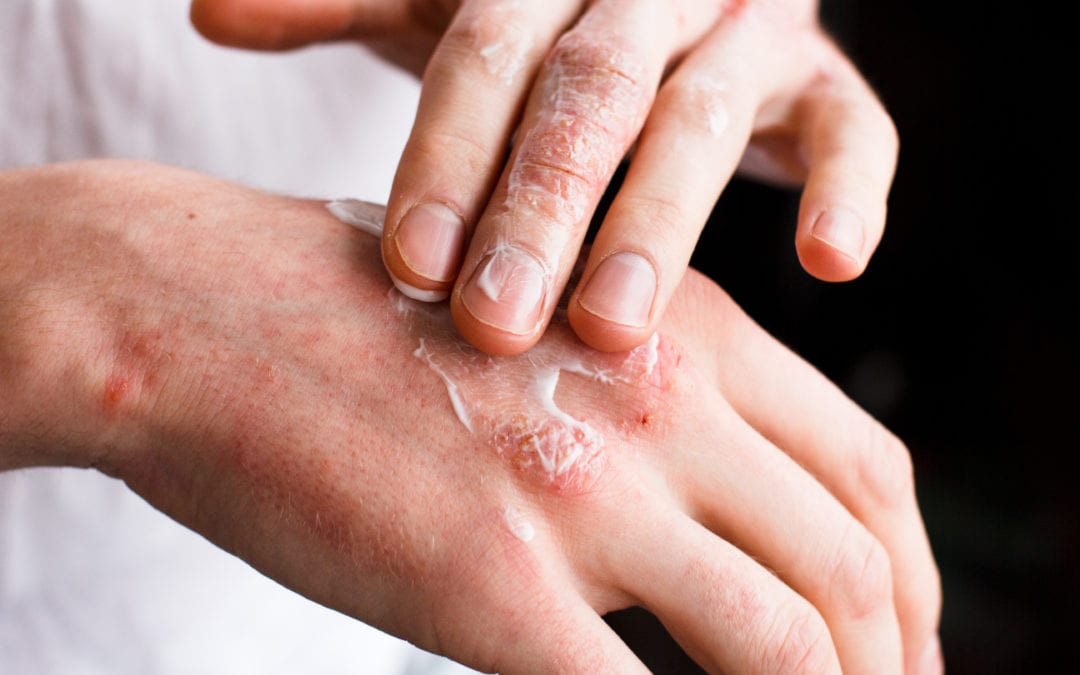Annoying and unpredictable, psoriasis is a persistent skin condition that’s not completely understood. The symptoms vary based on the different types of psoriasis, but they share a common characteristic: skin cells that multiply rapidly. We’ve put together some information about the disease for Psoriasis Awareness Month.
What is Psoriasis?
Psoriasis is a common skin condition that causes scaly, red, raised areas to appear on the skin. It most frequently affects the scalp, knees or outside of the elbows, but it can appear anywhere on the body. The affected skin may itch, burn or sting. The patches of irritated skin develop because psoriasis increases the life cycle of skin cells, causing them to multiply and build up rapidly. As the extra skin cells die, the sheer volume of excess cells causes the scales and red patches to form. Psoriasis is a chronic condition that tends to come and go in cycles.
Types of Psoriasis
There are five main types of psoriasis, and the symptoms vary by type.
- Plaque psoriasis – The most common type, it’s characterized by red, raised patches covered by a white buildup of dead cells. These plaques are often painful or itchy, and may crack and bleed.
- Guttate – Most often found in children and young adults, this form appears as small, water-drop-shaped lesions. It can be triggered by a bacterial infection, like strep.
- Inverse – This type appears as red lesions in body folds, often behind the knee, in the armpits, under the breasts and in the groin. Many times it appears at the same time as another type of psoriasis.
- Pustular – Characterized by white blisters or pustules, this kind of psoriasis is found most often on the hands and feet.
- Erythrodermic – Rare and particularly severe, this type leads to fiery redness over large areas of the body. It can cause severe pain and itching, and requires immediate medical attention.
People with psoriasis may also develop psoriatic arthritis, a condition that causes painful, swollen joints. The symptoms may be mild or severe, and any joint can be affected. Psoriatic arthritis isn’t usually as disabling as other types of arthritis, but it can still cause stiffness and joint damage.
Psoriasis Severity
The severity of psoriasis varies based on how much of the body’s surface area is affected as well as the impact on the person’s quality of life. Mild cases cover less than 3 percent of the body, moderate cases cover between 3 and 10 percent and severe cases cover more than 10 percent.
Causes of Psoriasis
No one knows for sure what causes psoriasis, but genetics and the immune system play an important role. The skin condition often runs in families, but it may skip generations. It most frequently develops in people between the ages of 15 and 35, with men and women developing the condition at equal rates. Psoriasis is not contagious, so you can’t get it from others.
Psoriasis Triggers
A number of factors can cause an episode of psoriasis. Learning to identify and avoid triggers may help reduce episodes. Common triggers include:
- Infections, like strep throat or skin infections
- Stress
- Skin injury, like scrapes, cuts, bug bites or severe sunburns
- Emotional trauma
- Heavy alcohol consumption
- Smoking
- Vitamin D deficiency
- Certain medications, including high blood pressure medication, lithium anti-malarial drugs and iodides
Risk Factors for Psoriasis
Anyone can get psoriasis, but certain factors put you at a higher risk.
- Family history
- Viral and bacterial infections
- Stress
- Obesity
- Smoking
Diagnosis of Psoriasis
Diagnosing psoriasis is usually straightforward. Your doctor or dermatologist will ask about your medical history and examine your skin, scalp and nails. They may also take a biopsy so they can examine the affected skin under the microscope.
Psoriasis Treatment
Treatments focuses on reducing inflammation and clearing the skin. They fall into three main categories: topical treatments, light therapy and systemic medications.
- Topical treatments – For mild to moderate psoriasis, creams and ointments can be used alone to treat affected skin. For severe cases, creams are usually combined with other forms of treatment. Topical treatments include topical corticosteroids, vitamin D analogues, Anthralin, topical retinoids, calcineurin inhibitors, salicylic acid, coal tar and moisturizers.
- Light therapy – Phototherapy uses ultraviolet light. Exposure must be carefully controlled to prevent skin damage and limit side effects. Types of light therapy include sunlight, UVB phototherapy, Goeckerman therapy, psoralen plus ultraviolet A (PUVA) and excimer laser.
- Systemic medications – Oral or injected medications are usually reserved for severe cases of psoriasis or those that don’t respond to other forms of treatment. Many of these drugs have possible severe side effects, so they are often used only for short periods of time. Systemic medications include retinoids, methotrexate, cyclosporine and drugs called biologics that alter the immune system.
Self-Care for Psoriasis
Self-care won’t cure psoriasis, but it can help you feel better and improve the appearance of the skin. Some home remedies that may help include:
- Take baths – Daily baths can help calm skin and remove scales. Avoid harsh soap and hot water; instead use lukewarm water and mild soap.
- Use moisturizer – Apply a heavy moisturizer after bathing or showering while the skin is still damp.
- Avoid triggers – Take steps to identify your common triggers, then try to avoid them.
- Avoid alcohol – The effectiveness of certain psoriasis treatments may decrease with alcohol consumption.
Psoriasis can be a challenging condition to cope with, but proper treatments help keep it under control. Be sure to communicate with your doctor and talk about any concerns you have about psoriasis. A healthcare group like SLMA is a great choice for patients with psoriasis because your doctor and dermatologist can work together to coordinate your treatment plan.

